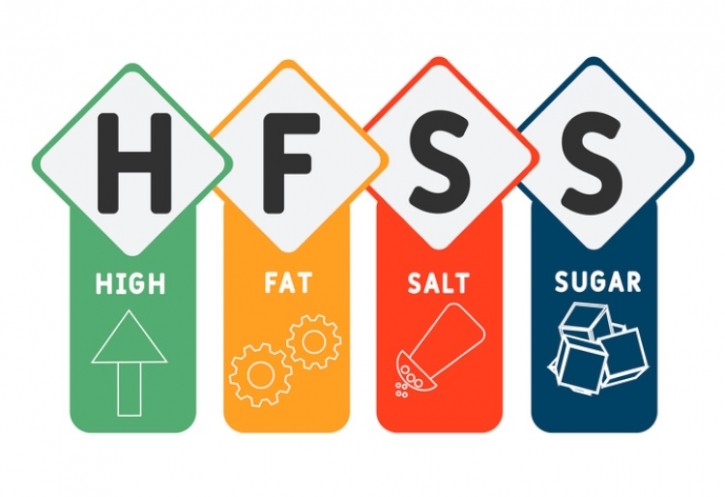Is your brand ready for the HFSS advertising shake-up?

In October 2025, the UK will tighten its rules around the promotion of HFSS products, marking a key initiative in its strategy to combat childhood obesity and enhance public health. A watershed ban on television and online advertising will be introduced, fundamentally changing how these products reach consumers, particularly younger audiences.
What’s the HFSS watershed?
Under the new regulation, TV advertisements for HFSS foods and beverages (scoring 4 points or more; and 1 point or more, respectively) will be prohibited before 9pm.
This measure is designed to reduce children’s exposure to ‘unhealthy’ food marketing during peak viewing hours in the afternoons and early evenings. The ban also extends to online platforms, limiting HFSS promotions via paid ads on social media, search engines and influencer marketing.
The rationale behind this is by limiting exposure to these ads, the UK government hopes to reduce the influence of HFSS food marketing on children’s food preferences and consumption habits.
Health experts rally behind HFSS ad restrictions
There has been widespread weigh in around the restriction of ‘unhealthy’ food advertising, particularly targeting children.
Health experts, including the World Health Organization (WHO), have repeatedly emphasized the link between the exposure of children to HFSS advertising and the rise in childhood obesity. Studies show that marketing unhealthy foods increases children's consumption of these products, influencing their food preferences and normalizing junk food in their diets.
Organizations like Cancer Research UK, the British Heart Foundation and Action on Sugar, too, strongly support the advertising ban. They argue this is a crucial step in reducing diet-related illnesses.
Action on Sugar calls for ban of child-friendly packaging; health minister brands plain wrapping ‘a step too far’
Campaigners have increasingly highlighted the role of digital advertising, with children spending more time online. Targeted ads on platforms like YouTube, Instagram and TikTok are seen as highly influential, with concerns about the effectiveness of online ad bans and the need for stricter regulation to prevent children from being targeted by unhealthy food brands.
How are foods classified as HFSS?
The categorization of HFSS is determined using the Nutrient Profiling Model (NPM) developed by the Food Standards Agency (FSA) and Public Health England (PHE).
Foods accumulate points for calories, fats, sugars and sodium, which push them towards HFSS categorization. On the other hand, points are subtracted for beneficial nutrients like fibre, protein and fruit or vegetable content.
If a food scores 4 points or higher – or a drink hits 1 point – it’s classified as HFSS.
For example, a snack high in sugar and fat but low in fibre or protein will score high, while a product containing healthier elements can offset these scores, potentially avoiding the HFSS label.
Industry pushback
The F&B industry – especially fast food and snack brands – has voiced concerns over the restrictions, citing potential negative impacts on revenue and marketing strategies. Some have argued the bans don’t fully address the root causes of obesity, such as lack of education and physical activity.
Countries like Chile, Canada and Mexico have already implemented strict advertising restrictions on HFSS products to children, with varying degrees of success. These measures, which often include warning labels and clear nutritional information alongside advertising bans, are seen as models for other nations considering similar actions.
While advertising restrictions are welcomed, health advocates emphasize these should be part of broader, multi-faceted strategies.
Along with bans, policies such as better food labeling, taxes on sugary drinks (already a successful initiative in the UK) and improved access to healthy foods are critical for fostering healthier dietary habits among children.
The fine balance of reformulation
Along with reassessing marketing strategies to find creative ways to engage with consumers, many producers have also begun reformulating their products to avoid the HFSS tag by gradually altering ingredients to improve nutritional content, though this process is complex and demands technical expertise.
Reformulation is a quagmire – and undoubtedly comes with additional costs – but a concept that no producer can afford to ignore. We’re here to help. Watch out for Bakery&Snacks’ webinar on Reformulation going live on October 25.
Addressing inequalities
Meanwhile, the Obesity Health Alliance (OHA) – which is supported by 88 health charities, medical groups and local advocates – has issued an open letter urging the Prime Minister to implement reforms to create healthier communities.
The OHA’s proposals focus on empowering local councils, especially in deprived areas, by prioritizing health in national planning guidance, restricting unhealthy food advertising, protecting councils from commercial pressure and restoring public health funding with a £1.5bn increase.
A recent YouGov poll reveals strong public backing for these measures, with 70% supporting a ban on ‘unhealthy’ food advertising near schools and 52% supporting restrictions on new fast-food outlets in such areas. However, 50% of respondents believe childhood obesity rates will remain unchanged under the current government, reflecting skepticism about its ability to drive meaningful change.
The government has initiated a consultation on how planning can address obesity, but campaigners stress the importance of fully implementing these reforms to empower local communities. The financial burden of obesity is significant, costing the NHS £6.5bn annually and the broader economy a whopping £98bn. Addressing diet-related ill health is crucial for economic growth and a sustainable NHS.
OHA director Katharine Jenner believes the UK’s high streets are dominated by unhealthy choices.
"Every child deserves access to affordable, convenient and nutritious food. However, high streets are flooded with unhealthy food and drink options, aggressively marketed in ways that limit free choice,” she said.
“Since 2016, the number of children and young adults diagnosed with Type 2 diabetes has increased by nearly 40%, fueled by rising levels of excess weight. Successfully implementing the government’s Child Health Action Plan would be a significant achievement, with the essential first step of giving local places the power to create healthier, active local communities for our children."
Darrell Gale, spokesperson for the Association of Directors of Public Health, concurs, adding the prevalence of unhealthy food is not a result of personal choice, but circumstances.
“The reality is that people don’t have the freedom to choose. Instead, they are forced by circumstances to buy cheaper, less healthy alternatives, bombarded by advertising and marketing, and are unable to access active transport, open spaces, or affordable leisure options,” he said.
“Only by creating healthier environments, where people have better access to the things we need to live healthier lives for longer, can we hope to address this inequity.”

















